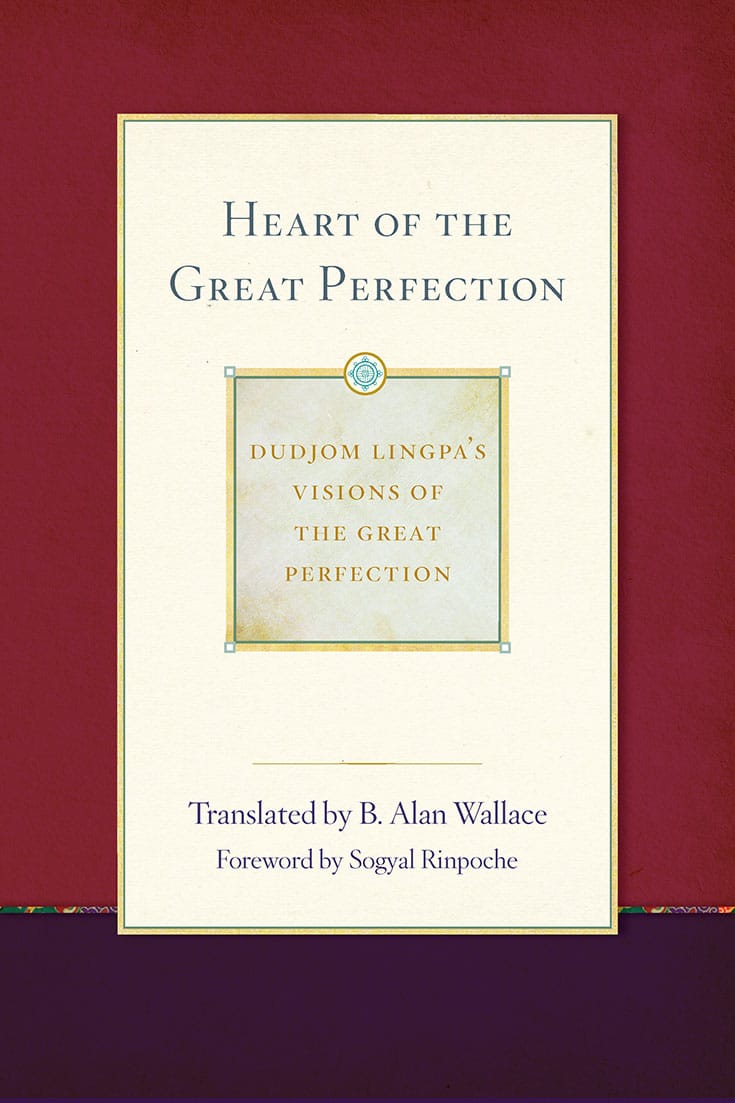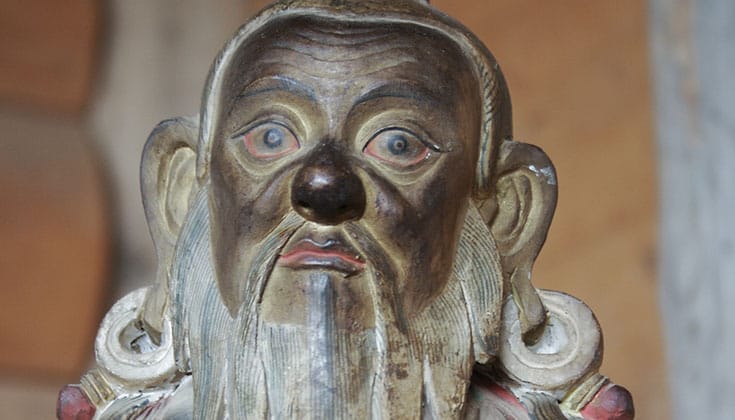The first Tibetan Buddhist retreat I attended, right out of college, was an intensive weekend at Tarthang Tulku’s Nyingma Institute in Berkeley in the fall of 1972. The retreat concluded on a most auspicious note, with the arrival of none other than Dudjom Rinpoche, the head of the Nyingma lineage. As a friend visiting from upstate exclaimed afterward, “My first day in the Bay Area, and I get to meet the holiest man in the world!”
Dudjom Rinpoche (1904–87) was a towering figure in twentieth-century Tibetan Buddhism whose many activities included helping the Tibetan exile community through the transition to diaspora and writing his authoritative history of the Nyingma school. He himself was the “mind emanation”—an incarnation or tulku—of Dudjom Lingpa (1835–1904), an extraordinary lama from Tibet’s northeastern nomad lands. Subject to visions of divine beings (especially Padmasambhava and Yeshe Tsogyel) from the age of three, Dudjom Lingpa became a charismatic teacher, treasure revealer (tertön), and celebrated author who was eventually recognized as an emanation of, among others, the Buddha’s disciple Shariputra, the great adept Saraha, and Khyeuchung Lotsawa, one of Padmasambhava’s twenty-five key pupils. He never became a monk and spent much of his life as a peripatetic yogi, traveling throughout Tibet and, it’s reputed, beyond, to various buddha realms and pure lands. At the end of his life, he is said to have passed into the distinctively tantric “rainbow body” by which an enlightened being may exit the world. His many sons and disciples shaped early twentieth-century Nyingma. And his voluminous writings—including a famous autobiography (A Clear Mirror), various treasure texts in the so-called “New Terma” tradition, inspiring spiritual songs, and lucid meditation manuals—are as influential today as when they were composed.

by B. Alan Wallace.
Wisdom Publications, 2016
344 pages; $19.95
Dudjom Lingpa’s importance, even in the twenty-first century, is due in part to the eloquence and effectiveness of Dudjom Rinpoche, who explicitly preserved and extended his predecessor’s work. It is also due in part to recent efforts by the revered Nyingma master Gyatrul Rinpoche and the accomplished American translator, writer, and teacher Alan Wallace to bring his teachings to a wider audience. Their collaboration has now culminated in the publication of Heart of the Great Perfection, Wallace’s superb collection of English translations of Dudjom Lingpa’s “Pure Vision” writings on Dzogchen, the central theory and practice of Nyingma. Unlike termas, which are long-hidden texts found in physical locales or the tertön’s mind, Pure Vision texts are directly received by a master while in a visionary ecstasy or dream.
When issued in its entirety, Heart of the Great Perfection will comprise three volumes totaling almost a thousand pages, which any serious student of Dzogchen will want to own. Volume one, under review here, contains the seminal Sharp Vajra of Conscious Awareness Tantra; a commentary on it entitled the Essence of Clear Meaning by Dudjom Lingpa’s disciple Pema Tashi; a text exploring the same terrain from a different angle called The Enlightened View of Samantabhadra; and a fascinating work full of visionary reports and meditation advice entitled The Foolish Dharma of an Idiot Clothed in Mud and Feathers. Volume two will focus on Dudjom Lingpa’s Buddhahood Without Meditation and two related texts by Sera Khandro, perhaps the most accomplished female lama of the twentieth century and consort of Dudjom Lingpa’s son, Drime Özer. Volume three will be devoted to a translation of the Vajra Essence, a fully expanded version of the teachings first broached in the Sharp Vajra.
The key to ascending through the eight phases is to appreciate and settle into the Dzogchen perspective on reality.
The set of practices around which every text in volume one pivots (except The Foolish Dharma) is an eight-step process, revealed to Dudjom Lingpa by the primordial buddha Samantabhadra. It takes the practitioner from devotion to a spiritual master, through calm abiding (shamatha) and insight (vipashyana) meditation, to such mystical practices as “cutting through” (trekchö) and “direct crossing over” (tögel), all the way to buddhahood and the rainbow body. The key to ascending through the eight phases is to appreciate and settle into the Dzogchen perspective on reality, according to which the fundamental nature of ourselves—and the cosmos—is our inner pristine awareness (rikpa), also described by terms such as buddhanature, the dharma-body of a buddha, or pure, absolute space.
Because pristine awareness is what we are and always have been, the spectacle of deluded selves spinning endlessly through samsara is in certain ways quite misleading, since at the deepest level we always have been buddhas. Our hopes and fears, our joys and sufferings, and the world in which they play out are all simply emanations of this pristine awareness; they dazzle and deceive us so we do not see their true source and substance. Thus, the eight-phased path is simply a process of rediscovering an innate enlightenment that has never been lost. With its panoply of complex and sometimes unconventional tantric practices, it imaginatively explores the relationship of emptiness, mind, and things and plumbs the depths of contemplative experience. In doing so, it reclaims a purity from which we have never strayed and uncovers our own primordial great perfection—a perfection that will, in T.S. Eliot’s words, “fructify in the lives of others.”
In Wallace’s view, Dudjom Lingpa’s Pure Vision teachings can be boiled down to four essential practices: shamatha, vipashyana, cutting through, and direct crossing over. “Accomplishing these four practices alone,” he notes, “is in principle sufficient to achieve any one of the three levels of rainbow body that signify the culmination of the path of the Great Perfection.” And because the teachings “transcend all limitations of specific historical eras and cultures,” it may well be, Wallace writes, that prophecies Dudjom Lingpa received in China to the effect that his teaching would flourish among “westerners” referred not just to Tibetans but also to “those of us living today in the cities of the West.”
These comments prompt some reflections on the increasing popularity of Dzogchen in the Euro-American world. Despite my own early exposure to Nyingma teachings in Berkeley, I have studied mainly with Gelukpa masters and typically frequented Gelukpa centers. It has been intriguing over the years to see many of my Gelukpa friends drawn to Nyingma, in some cases defecting completely, in other cases combining the two traditions. Alan Wallace himself is an example of this: he began serious Buddhist practice as a Geluk monk in India and Switzerland, but in time he began to study with Nyingma masters such as Gyatrul Rinpoche, and for at least two decades he has focused much of his writing and teaching on the Great Perfection. What is the appeal of Dzogchen, whether for an experienced practitioner like Wallace or a newcomer to Tibetan Buddhism? Of many possible explanations, three stand out.
It is optimistic. Dzogchen asserts, with other Mahayana traditions, not only that we all have within us the capacity to become fully enlightened buddhas but also that in some sense we already are buddhas, in that pristine awareness is the fundamental nature of ourselves and the world simply waiting to be rediscovered. This sort of “gospel of buddhanature,” running counter to the “tragic sense of life” influential in traditional European culture, is more appealing to many Western seekers, accustomed as they are to the psychological lingo of self-improvement, than are accounts of Buddhism that dwell on our delusion and the sufferings they incite and emphasize that attaining enlightenment is a process requiring years, and perhaps lifetimes, of effort.
It is experiential. From the start, Buddhists have debated the relative importance of scholarship and meditation on the path to awakening. Dzogchen teachers and texts clearly place a premium on meditative experience, exploring it with great sensitivity and sophistication while tending to downplay the philosophical gymnastics emphasized by other schools, especially the Geluk. The Dzogchen approach is appealing because most Westerners are drawn to Buddhism by its contemplative traditions, with their focus on inner experience. That may at best be transformative and at the very least provide structure and meaning for our complex, modern lives.
It is direct. Although nested within the rich, complex, tantric ethos of Tibetan Buddhism, Dzogchen discourse (especially that of cutting through) is marked by what Bernard Faure calls a “rhetoric of immediacy,” which asserts that ultimate reality—our pristine awareness—is directly and easily accessible to us because it is what we are, beyond all our anxious striving and intellectual chatter. As with presentations of Vipassana, Zen, and Mahamudra, this rhetoric is appealing in the West because it seems to promise a way to happiness—or more—that does not require excessive ritual or the adoption of “alien” ideas and practices. We are invited simply to know our own mind, as it really is.
We may already be buddhas, but the delusions that keep us from fully recognizing our true nature are deeply rooted and still require concerted effort to eliminate.
The appeal of the Great Perfection to Westerners is thus understandable. As anyone who studies Dzogchen learns quickly, however, it’s not nearly so simple. We may already be buddhas, but the delusions that keep us from fully recognizing our true nature are deeply rooted and still require concerted effort to eliminate. Meditative experience may be front and center in Dzogchen, but Nyingma has a long and distinguished history of philosophical inquiry, and its masters and texts warn us constantly against the deceptions that may arise in meditation. They caution us, too, that meditation itself should not be an object of attachment. Our pristine awareness may in principle be immediately accessible because “it is what we are,” but its simplicity is deceptive, and we are in fact far likelier to uncover it if we adopt attitudes and actions not natural to most Westerners, including guru devotion, the generation of imaginal worlds and beings, and (as in direct crossing over) spontaneous and unconventional yogic behavior of a sort not generally countenanced in “the cities of the West.”
His commitment to spreading the tradition notwithstanding, Wallace clearly recognizes all this, and it is to his credit that Heart of the Great Perfection gives us not just a stripped-down Dzogchen aimed solely at Westerners looking for an easy path but also a fully rounded version of the Great Perfection practiced by Tibetan masters, with its rich metaphors, gnostic metaphysics, vertiginous paradoxes, complex meditation instructions, and, yes, challenging cultural idiosyncrasies. How Dudjom Lingpa’s Pure Vision teachings will settle in the lives and imaginations of Western practitioners remains to be seen, but we are indebted to Wallace, and to those who inspired and assisted him, for providing us with such a rich and vital resource for coming to terms with the profundities and puzzles of the Great Perfection.


